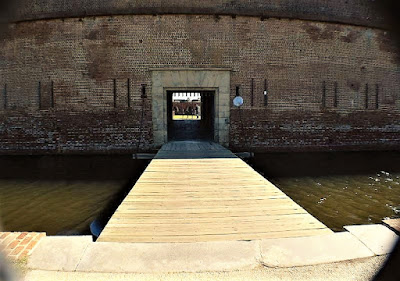On Tuesday we spent several hours at Fort Pulaski which is located on Cockspur Island just East of Savannah, GA. Construction of Fort Pulaski was started in 1829 and completed in 1847. Its purpose was to protect the coast and the harbor of Savannah. It was believed to be impenetrable as the 7-1/2 foot thick walls were believed to be out of range of any enemies guns as a result of its physical location. The fort was seized by the the Georgia State Militia in January of 1861 and was immediately transferred to the Confederate States Of America. What they hadn't planned on was that the Union had new canon technology, the rifled, 30 pounder, Parrot gun, which could reach several miles. On April 10th and 11th, 1862, the walls of the fort were breached in less than 30 hours of bombardment forcing the Confederates to surrender the fort. The Union used the fort for a prison camp for Confederate officers for much of the rest of the war. Many of the scars of the bombardment are still visible on the South and Southeast walls.
Demilune that protects the rear of the fort - it is a triangular piece of land with a network of underground powder magazines and tunnels to gun emplacements.
The protective moat that surrounds the fort
Entrances to some of the underground tunnels of the demilune
One of the underground powder magazines in the demilune
The draw bridge - the only entrance to the fort
One of many period canons at the fort
View of the parade grounds and the north wall
Commanding officer's quarters
Brass canon and embrasure
A rifled "Parrot" canon I believe - not sure if it was used in siege - the rifled canon used a conical shaped round - much like the shape of a modern day bullet. The round had a skirt that engaged the rifling which caused the shell to rotate providing greater distance and accuracy
Traditional Canon (round ball)
Traditional Canon (round ball)
Part of the prison where Confederate officers were held.
1862 Union bread crates
Another view of the fort
Remains of the bombardment
Remains of the bombardment
A memorial to the Confederate officers who were imprisoned here in 1864 and 1865
A memorial to those prisoners who died in captivity at Fort Pulaski
We walked the dikes (about 2 miles) that surround Fort Pulaski and did see one alligator - he was about 5 ft. long. Building the dikes was one of the first assignments of Robert E. Lee after graduating from West Point. The dikes control the water level in the moat and protect the fort from the ocean tides.
View of the fort from one of the dikes
I didn't know they had cacti in Georgia - lots of prickly pears on the dikes
Cockspur lighthouse just offshore from the fort.
The lighthouse
































